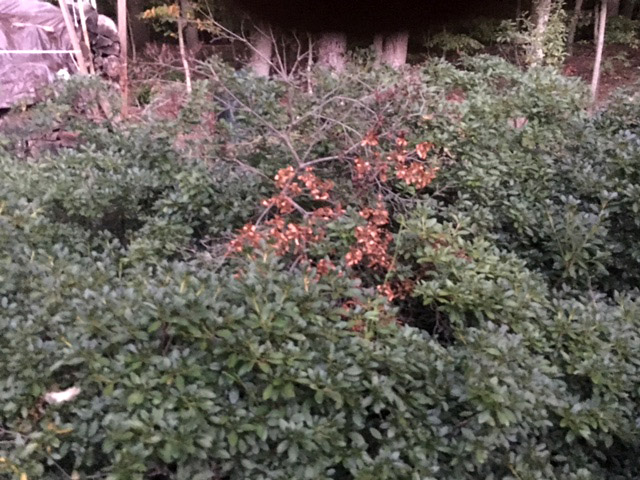Can mulching leaves into lawns cause problems?
Ted in Glyndon writes: “Does mulching leaves into the lawn in the fall hurt the grass or help it? I worry that it might be bad for three reasons: adding food that would encourage late growth, cutting off air circulation and sun, and inviting fungus and decay.”
Middle one first, Ted: That question kinds of defines your actual guideline on this technique. You want to shred some leaves back into the lawn to add much-needed organic matter, but not so many that you make a layer thick enough to smother the turf.
So, if just a few leaves land on your lawn, absolutely mulch them all back in as you mow. But if the lawn is covered inches deep in leaves, blow, rake or vacuum most of them off. (Be sure to shred and save them for future mulch and compost-making.) Mow the equivalent of a single, 1-inch layer of leaves back into the lawn over the course of the fall.
Do mowed-in leaves feed too late or cause mold misery?
Ted in Glyndon likes the idea of mulching leaves into his lawn, but he worries that the leaves would add food that might encourage late growth or invite fungus and decay. Good questions!
Now: This would be a bad time to feed almost any other plant in your landscape, Ted, but cool season lawns of fescue and bluegrass don’t go truly dormant over the winter and are actively growing much of the time. And unlike chemical fertilizers, mulched-in leaves release their nutrients very slowly and won’t cause any kind of late-season growth flush.
Fungus and decay? These are serious concerns when whole leaves are left on a lawn. Whole leaves mat down like a tarp, trapping moisture and causing all sorts of mold and mildew problems underneath. (They can also just plain smother the grass!)
But tiny pulverized pieces do just the opposite — they bring all sorts of beneficial microbial life down to the soil line to help fight disease and break down thatch.
Dead branches on azaleas

Joe in Fairfax writes: “Four years ago I bought a home with some beautiful azaleas around the property. The plants, which otherwise seem healthy, will suddenly have a single branch that dies starting at the tip and then spreads to consume the whole branch and then to other branches. Do I need a systemic pesticide?”
No, Joe, and I don’t recommend you use one on your azaleas either.
Now: It is common for azaleas to occasionally develop a bad branch or two. And one of the first rules of gardening is to remove dead branches from any type of plant as soon as you see them. This removal serves to prevent the spread of any potential pest or disease problem to the rest of the plant. But more importantly, makes your neighbors think that you’re a more talented gardener than reality might suggest.
Bad mulch = azaleas that struggle
Joe in Fairfax wants some advice about his azaleas as he makes plans for the coming season.
Well, Joe, some of the photos you sent showed pretty healthy plants with a single dead branch here and there, which is perfectly normal. But some of the plants were pretty messed up, at least one was “really, most sincerely dead.” And all of them seemed to have dyed wood mulch around their base, which is not good for any plant but especially bad for azaleas and rhododendrons.
Remove all of the old mulch and replace it with an inch of milled peat moss to provide the soil acidity these plants require. And then cover the peat moss with an inch of compost (not composted manure) to provide organic matter.
You can remove the dead one now; it’s not going to look any better than it already does, which is awful. Carefully prune out any completely dead branches on the other plants as well, but don’t touch any live ones.
Then prune the plants for shape and airflow in the spring after the flowers fade, repeat the peat moss and compost and don’t use lawn chemicals anywhere near these plants.
It’s rosemary Christmas tree time!
The holiday season is now officially upon us with the arrival of those wonderful Christmas tree-shaped, live rosemary plants at garden centers and upscale supermarkets.
These plants are aromatic, attractive and a very good deal even if you just buy them for the amount of actual rosemary you can harvest from one. But they are also terribly root-bound! These cute little “trees” were pruned down from fairly large shrubs and then jammed into small pots. So if you want to keep them alive longer than a week, you must transplant them into a pot at least twice as big ASAP.
Get a bag of light, loose potting soil and a good-size plastic pot with good drainage holes in the bottom. Pull the plant out of its original pot, pour some potting soil into the bottom of the new pot until the plant can sit at the same height it used to. Position the plant and then use more potting soil to fill in the sides of the new pot.
Then sit the newly-planted pot in a few inches of water for an hour to let it get really saturated. Repeat this watering whenever the pot feels light, but do not overwater or cover the drainage holes of the new pot with foil — wet feet will kill rosemary.
These little trees look great inside. But rosemary is also pretty hardy, so you can display your plant outside for the holidays as well. Just bring it inside on any nights that dip into the low 30s or below.
With any luck, you’ll have a big, live rosemary plant to go into your garden in the spring!







